Unit Test (Solutions): Light: Mirrors and Lenses | Science Curiosity Class 8 - New NCERT PDF Download
Time: 1 hour
M.M. 30
Attempt all questions.
- Question numbers 1 to 5 carry 1 mark each.
- Question numbers 6 to 8 carry 2 marks each.
- Question numbers 9 to 11 carry 3 marks each.
- Question numbers 12 & 13 carry 5 marks each.
- 1-mark questions include MCQs.
Q1: A mirror with reflecting surface curved inward is called (1 Mark)
(i) plane mirror
(ii) convex mirror
(iii) concave mirror
(iv) cylindrical mirror
Ans: (iii)
A concave mirror has its reflecting surface curved inward (like the inner side of a spoon), producing enlarged/erect images when close and inverted images when far.
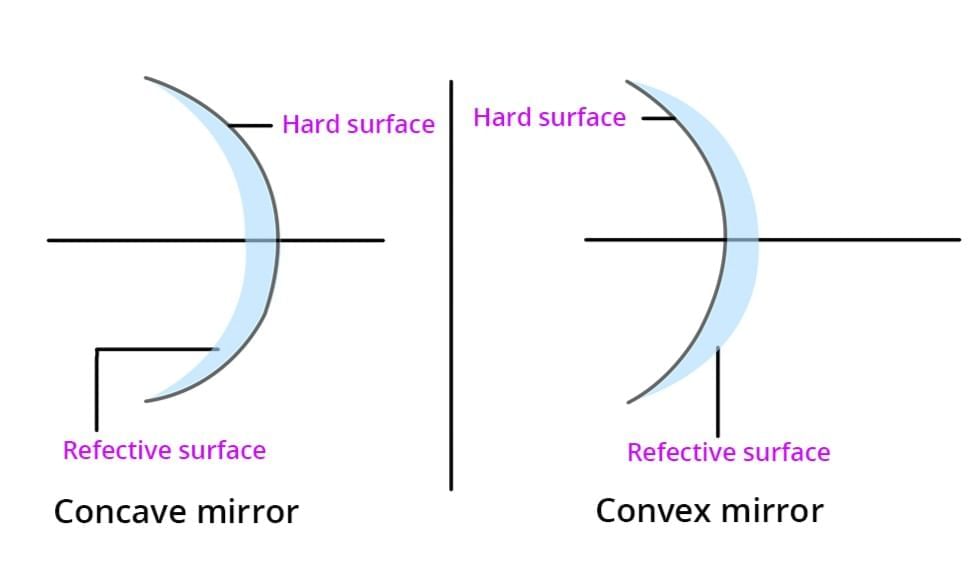
Q2: Which mirror is used as a vehicle’s side-view mirror and why? (1 Mark)
(i) Concave, to magnify the view
(ii) Plane, to show true size
(iii) Convex, to give a wider field of view
(iv) Concave, to converge light
Ans: (iii)
Convex mirrors always form erect, diminished images and provide a larger field of view, letting the driver see more of the road behind—hence the warning “objects in mirror are closer than they appear”.
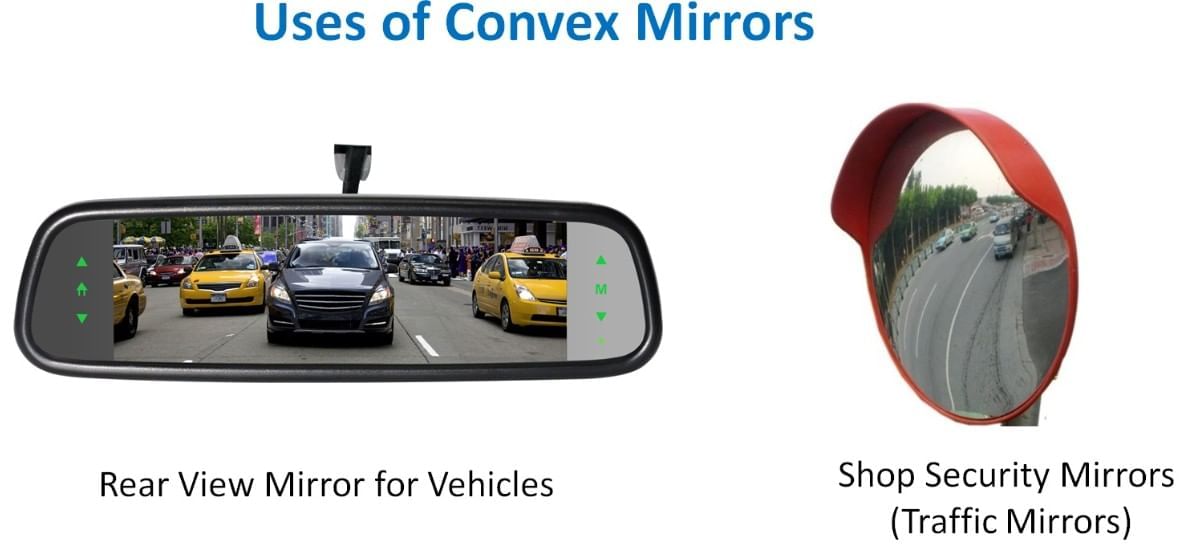
Q3: The law of reflection states that the angle of incidence is (1 Mark)
(i) greater than angle of reflection
(ii) equal to angle of reflection
(iii) less than angle of reflection
(iv) independent of angle of reflection
Ans: (ii)
Law 1: Angle of incidence i equals angle of reflection r.
Law 2: The incident ray, normal, and reflected ray lie in the same plane.
Q4: A convex lens is also called a (1 Mark)
(i) diverging lens
(ii) converging lens
(iii) cylindrical lens
(iv) neutral lens
Ans: (ii)
A convex lens is thicker at the centre; it converges parallel light beams to a point and can focus sunlight to a bright spot.
Q5: The image in a convex mirror is always (1 Mark)
(i) inverted and enlarged
(ii) erect and same size
(iii) erect and diminished
(iv) inverted and diminished
Ans: (iii)
Convex mirror forms erect, diminished images for all object positions, useful for wider view.
Q6: Distinguish between concave and convex mirrors on the basis of image nature for close objects. (2 Marks)
Ans: Concave mirror (object close to mirror): image is erect and enlarged (used by dentists).
Convex mirror: image is always erect and diminished, even when close (used as side-view mirrors and road safety mirrors).
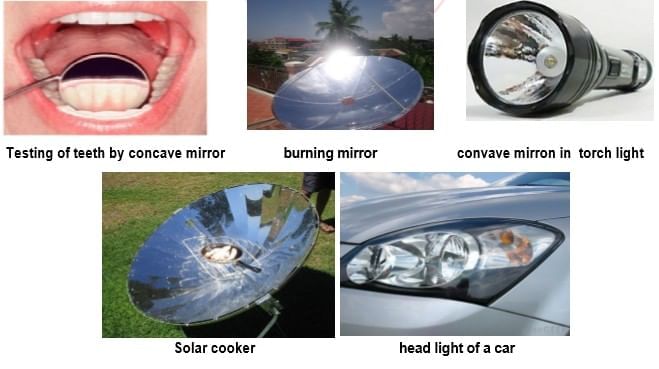 Uses of Concave Mirrors
Uses of Concave Mirrors
Q7: State the two laws of reflection and name the three rays/lines used to describe them. (2 Marks)
Ans: Laws: (1) Angle of incidence equals angle of reflection (i = r).
(2) Incident ray, normal at the point of incidence, and reflected ray lie in the same plane. Terms: incident ray, normal, reflected ray.
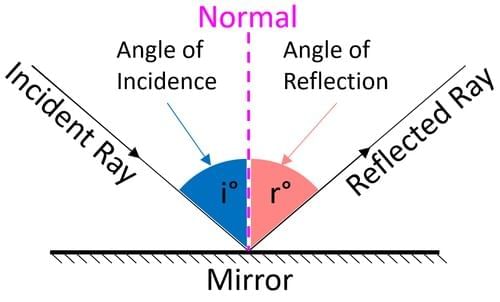
Q8: A comb-and-torch setup produces multiple parallel light beams onto (a) plane mirror (b) concave mirror (c) convex mirror. Describe the reflected beams in each case. (2 Marks)
Ans: (a) Plane mirror: reflected beams remain parallel.
(b) Concave mirror: reflected beams converge (come together). (c) Convex mirror: reflected beams diverge (spread apart).
Q9: A student observes her face in a shiny spoon. Explain the difference between images seen in the inner and outer surfaces and identify the mirror type mimicked by each surface. (3 Marks)
Ans: Inner surface (curved inward): behaves like a concave mirror—near the spoon, image is erect and enlarged; farther away, image becomes inverted and can change size. Outer surface (bulging outward): behaves like a convex mirror—image is always erect and diminished.
Q10: Explain why a concave mirror (or convex lens) can ignite paper when used in sunlight, while a plane mirror cannot. (3 Marks)
Ans: Concave mirror and convex lens are converging devices: they focus parallel sun rays to a small bright spot, concentrating energy and heating the spot enough to burn paper. A plane mirror only reflects light without converging it, so energy is not concentrated at a point.
Q11: State how objects appear through (a) a convex lens and (b) a concave lens as the object distance increases from the lens. (3 Marks)
Ans: (a) Convex lens: when the object is close, the image appears erect and enlarged; as distance increases, the image becomes inverted—first enlarged, then smaller as distance grows further.
(b) Concave lens: image is always erect and diminished; its size varies slightly with object distance but remains smaller than the object.
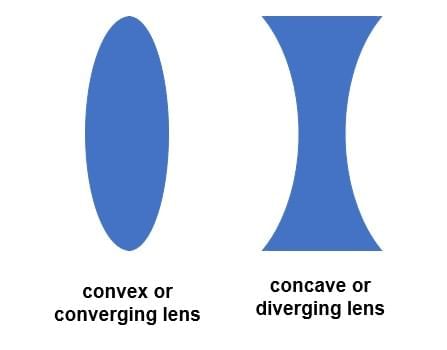
Q12: Laws of reflection — application. (5 Marks)
(a) A light ray strikes a plane mirror with angle of incidence 40°. What is the angle the reflected ray makes with the mirror surface? Show reasoning.
(b) In three cases, a ray
(i) falls along the normal,
(ii) the mirror is tilted but the ray still falls along that new normal, (iii) the ray makes 20° with the normal. For each, state the angle of reflection and the direction of the reflected ray relative to the mirror.
(c) State and justify the “same plane” law using the bent-chart experiment.
Ans:
(a) i = 40°. Since i = r, angle of reflection r = 40°. The angle the reflected ray makes with the mirror surface equals 90° − r = 50°.
(b) (i) Ray along normal: i = 0°, so r = 0°; ray retraces its path.
(ii) Even if tilted, if the ray is along the (new) normal, i = 0°, r = 0°; it retraces. (iii) If the ray makes 20° with the normal, i = 20° and r = 20°; the reflected ray is symmetric about the normal on the other side, making 20° with the normal and 70° with the mirror surface.
(c) Same-plane law (Second law of reflection):
- Statement: The incident ray, the normal at the point of incidence, and the reflected ray all lie in the same plane.
- Justification (bent-chart experiment): Place a plane mirror on a sheet and trace the incident beam and the normal. The reflected beam appears on the same flat sheet, showing coplanarity. If you bend or lift part of the sheet so it is no longer in the same plane, the reflected spot on the bent part disappears/misaligns, demonstrating that reflection requires the incident ray, normal, and reflected ray to remain in one plane.
Q13: (a) A woman walks toward a large convex mirror in a museum. Describe how her image appears as she approaches.
(b) A magnifying glass is held above text. What kind of lens is it and what happens as you increase the distance from the page?
(c) Match the following mirror/lens with the image property and use:
(i) Concave mirror,
(ii) Convex mirror,
(iii) Convex lens,
(iv) Concave lens — with:
(A) dentist’s mirror/enlarged close-up,
(B) vehicle side mirror/wide view,
(C) magnifier/enlarged close object,
(D) always erect diminished view. (5 Marks)
Ans:
(a) In a convex mirror, the image is always erect and diminished; as she approaches, the erect image remains but its size appears to increase slightly, yet stays smaller than actual.
(b) A magnifying glass is a convex lens. At suitable close distances (within focal length), the text appears erect and enlarged; as you move the lens farther beyond certain distances, the viewed image can become inverted if you form a real image farther away, but for simple hand use near the page, you observe enlarged, erect images.
(c)
(i) Concave mirror → (A) dentist’s mirror/enlarged close-up.
(ii) Convex mirror → (B) vehicle side mirror/wide view.
(iii) Convex lens → (C) magnifier/enlarged close object (also forms real inverted images at larger distances).
(iv) Concave lens → (D) always erect diminished view.
|
59 videos|236 docs|13 tests
|
FAQs on Unit Test (Solutions): Light: Mirrors and Lenses - Science Curiosity Class 8 - New NCERT
| 1. What are the basic principles of reflection and refraction in mirrors and lenses? |  |
| 2. How do concave and convex mirrors differ in their applications? |  |
| 3. What is the lens formula, and how is it used in optics? |  |
| 4. How does the focal length of a lens affect image formation? |  |
| 5. Can you explain the significance of the critical angle and total internal reflection? |  |
















